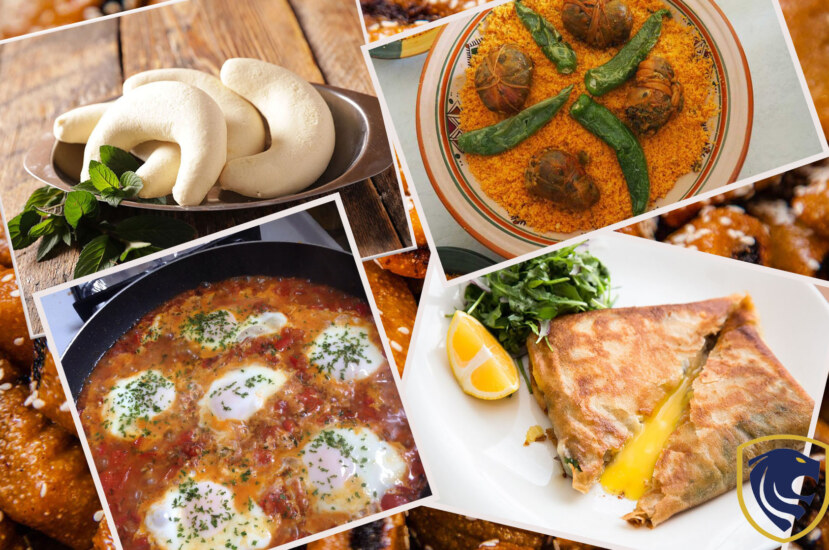Tunisia, located on the Mediterranean coast, has a culinary legacy as rich and varied as its history. Tunisian cuisine is a rich tapestry of tastes and methods influenced by Berber, Arab, Ottoman, and Mediterranean traditions. The country’s food represents a centuries-old blend of spices, fresh vegetables, and aromatic herbs, from the busy marketplaces of Tunis to the quiet kitchens of rural houses. Traditional Tunisian meals, revered for their authenticity, honor the skill of blending simplicity with complex tastes. We go into the heart of Tunisia’s culinary history in this examination of its greatest traditional meals. We are tracing the roots of famous dishes that have endured the test of time. So, it will allow you to experience the essence of Tunisian culture via its wonderful cuisine.
Couscous
Tunisia’s Eternal Culinary Jewel. Couscous, a beloved Tunisian delicacy, reflects the essence of tradition and togetherness. It’s made from steamed semolina wheat granules and serves as the base for a variety of tasty recipes. Couscous is a meal cooked with great care, each granule symbolizing the creativity of Tunisian culinary history. Moreover, it is often served with a delicious stew of meat or vegetables. The steaming procedure results in a light, fluffy texture that serves as the ideal canvas for the bright flavors that follow. Couscous represents the ingenuity and resourcefulness of Tunisian cooks, whether it’s garnished with juicy lamb, chickpeas, carrots, or a combination of aromatic spices. Its preparation is traditionally a community affair that brings families and friends together.

Couscous
Couscous’ importance extends beyond its taste. It represents togetherness passed down through generations. Couscous is more than a meal in Tunisia. It’s a cultural symbol, a celebration of tastes and community. Its continued appeal reflects the country’s passion of authenticity, making it an essential aspect of Tunisian gastronomy and a must-try for anybody looking for a real flavor of this North African jewel.
Brik
Brik is a Crispy Culinary Delight from Tunisia. Also, this popular Tunisian street meal, combines a delicious array of textures and tastes. This exquisite envelope-like thin, crispy pastry conceals a delightful secret within. Its filling is frequently a harmonic combination of ingredients, such as a runny egg, flaky tuna, capers, and a burst of fresh parsley. Brik’s beauty rests not only in its crisp surface. But also in the contrast it provides: the warm, savory interior against the crunchy shell produces a sensory symphony. Then Brik changes in heated oil, becoming golden and deliciously crispy. This exquisite delicacy, whose origins are firmly established in Tunisian culinary culture, evokes nostalgia in residents while captivating visitors with its perfume and flavor.

Brik
It’s more than just a snack. It’s an experience to be experienced on crowded Tunisian streets and treasured in homes on special occasions. Moreover, Brik represents the inventive spirit of Tunisian cuisine, transforming modest ingredients into delicious delights. Brik is a cultural symbol, embodying the country’s rich history with every crispy mouthful, and each bite is a monument to the nation’s culinary genius.
Harira
Harira is a bowl of Tunisian soul. It is a rich tapestry of ingredients that is synonymous with Tunisian cuisine. This fragrant recipe combines a kaleidoscope of flavors. For instance, it includes delicate lamb, lentils, chickpeas, tomatoes, and a mosaic of spices. Harira represents comfort and tradition, with its origins dating back generations. It represents unity and camaraderie for Tunisians, and is served especially during Ramadan and other events. The complexity of Harira is what distinguishes it; the combination of tomatoes and meat makes a powerful basis, while lentils and chickpeas give heartiness. In addition, spices ranging from cumin to coriander give the soup with a warm, earthy scent. Fresh herbs like cilantro and parsley are frequently used to garnish the dish, adding to its freshness.

Harira
Harira is more than just food. It is a cultural icon, symbolizing the warmth of Tunisian hospitality. Every mouthful brings the flavor of family gatherings and shared meals. Its rich tastes feed the body while also evoking a sense of kinship and heritage. Harira is a tribute to Tunisia’s culinary talent, reminding the world that genuine gastronomic creativity is found in the capacity to combine simplicity and complexity into a soul-soothing masterpiece.
Lablabi
Lablabi, a beloved Tunisian dish, is a savory testimony to simplicity and inventiveness. This soup, which is frequently regarded as a morning treat, comprises simple ingredients that have been raised to incredible heights. Lablabi is made out of chickpeas that have been boiled until soft and then soaked in a fragrant broth of cumin, garlic, olive oil, and occasionally hot harissa. The unexpected inclusion of stale bread alters this recipe, letting it to soak up the fragrant liquid and transform it into a hearty, satisfying dinner. Moreover, Lablabi exemplifies ingenuity, with chefs creatively repurposing stale bread to create a meal that has become a culinary icon. The appeal of lablabi is found in its contrasting textures and powerful flavors.

Lablabi
For instance, the softness of chickpeas contrasts with the crunch of bread, while the warmth of spices complements the tang of olive oil. Lablabi, which is frequently topped with paprika and capers, exemplifies Tunisia’s talent for transforming simple ingredients into gourmet marvels. Lablabi is more than a soup. It embodies the nation’s capacity to find comfort and happiness in the mundane, making it a treasured element of Tunisian culinary tradition.
Mechoui
Mechoui is a gastronomic show that honors the skill of roasting and is firmly established in Tunisian heritage. This recipe transforms the roasting of a whole lamb or goat into a huge community event, generally reserved for special events and milestone celebrations. Also, the meat is seasoned with a medley of spices to ensure it’s loaded with taste before being slow-cooked to delicate perfection. The end result is a delicious, luscious meal that melts in the tongue. The enticing scent of roasting meat permeates the air, bringing families, neighbors, and friends together in a festive atmosphere. What distinguishes Mechoui is its capacity to captivate not just taste senses but also hearts.

Mechoui
It is more than just a meal; it also represents kindness and hospitality. Sharing a perfectly prepared roasted feast represents solidarity and tradition, making every meal a monument to Tunisian culture. Mechoui epitomizes the essence of festivity, with its delicate, tasty meat and rich, smokey scent, reminding Tunisians and visitors alike of the country’s culinary prowess and the warmth of its welcome.
Ojja
Ojja is a Tunisian spice infusion served on a plate. This dish encompasses a fascinating combination of tastes and textures. This historical meal is a spicy treat cooked with tomatoes, peppers, eggs, and the well-known Tunisian sausage, merguez. Ojja is a sensory explosion on the taste buds, cooked with a range of fragrant spices such as cumin, coriander, and caraway seeds. The meal has a brilliant crimson color from the ripe tomatoes, making it visually appealing. The delicious merguez sausage, sizzling in the middle of the sautéed veggies, lends a smoky, spicy flavor that adds depth to the entire meal. What distinguishes Ojja is its versatility; depending on the chef’s spice preferences, it may be mild or spicy.

Ojja
Ojja, which is frequently topped with fresh cilantro or parsley, is served hot with crusty bread. It enables guests to relish every tasty mouthful. Beyond its flavor, Ojja conveys a narrative of Tunisian culinary expertise. So, it demonstrates the country’s ability to convert modest materials into a gastronomic feast. Moreover, this meal embodies the heart of Tunisian cuisine: robust, fragrant, and completely seductive, making it a must-try for anybody looking for a true experience of Tunisia’s culinary history.



